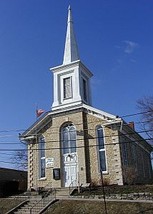Old Stone Church - Lemont Historical Society
Introduction
Text-to-speech Audio
Images
Photo from the Lemont Historical Society - http://www.lemonthistorical.org/

Backstory and Context
Text-to-speech Audio
The Old Stone Church, a former Methodist church from 1861 - 1970, now serves as museum for the Village of Lemont,1 but it also represents the long history of Lemont, its ties to the I&M Canal, and the genesis of Chicago.
History of the Building2
In 1857, Methodist Episcopal congregates held Sunday School and Sunday services in the town's original town hall. In 1861, the congregation laid the Old Stone Church's cornerstone on September 14, 1861, and then opened it for services in November of that year.
The building cost $1,940 to build, is 35 x 60 feet, and is comprised of Lemont stone tailings donated by Lemont's Brown Quarry.3 The Old Stone Church design is reminiscent of small churches found in New England, which is no surprise since many settlers to Lemont hailed from the New York - New England area.
In addition to its theological usage, the Old Stone Church,
- Served as a center for community activities.
- It was used as a recruiting depot during the Civil War.
- Existed as a center of reform and temperance movements. Rev. J. Franklin Clancy, a Methodist minister fought against liquor consumption and other "sin activities," such as gambling, prostitution and political corruption that were common during the building of the Sanitary and ship Canal from 1892 - 1901.
Brief History of Lemont
The Old Stone Church predates Lemont's official incorporation as a town. Lemont's first attempt at settlement after the displacement of Native Americans was the “paper town”4 of Keepataw,5 platted in 1836, followed by Athens in 1839. Lemont proper was not incorporated until 1873, on land previously occupied by the defunct Keepataw.6
Lemont has two histories, in a sense - one tied to Chicago and the I&M Canal and one tied to its famous, previously mentioned, quarries. Construction of the I&M Canal began in 1836 and then completed in 1848. The canal linked the Illinois River and Lake Michigan to make a direct waterway to the Mississippi River and, in a sense, connect New Orleans to New York. In an era where water navigation reigned supreme, that made Chicago and the surrounding regions a place in which to invest.
Almost all the early town migrants and immigrants arrived in order to work on the canal, as either contract holders or laborers. Contract holders mostly were comprised of Americans from New England while immigrants (Irish, German, Scandinavians, and others) dominated the unskilled workforce. As a result, Lemont's population reached 3,000 people by 1848.7
The canal digging led to the aforementioned discovery of the highly coveted Lemont limestone.As the quarries grew, more immigrants arrived, such as Poles, Bohemians, Austrians, and Italians, who also worked as low-paid laborers and in typical 19th century fashion, enjoyed many skirmishes with quarry owners. Indeed, in 1885, a strike resulted in the arrival of the Illinois Militia for the intentions of breaking it, resulting in three deaths and many injuries -- more died shortly thereafter in another skirmish.
By the 1890s, Lemont had grown to more than 10,000 people, much of that due to mining and quarrying. The downtown region, not far from Old Stone Church, gained fame for its "Smokey Row," an area dominated by taverns and brothels that was generally regarded as one of the least "moral" places in the country.
Final Comments:
Over time, settlers remained and formed a village that had less to do with quarrying and more to do with building a community. The Old Stone Church represents one of the many places that served as a place for forging a community.
Cite This Entry
Powers, Mathew. "Old Stone Church - Lemont Historical Society." Clio: Your Guide to History. March 27, 2019. Accessed January 8, 2025. https://theclio.com/entry/24952
Sources
2 The building's history is largely the product of the Lemont Historical Society. See, "The Story of the Old Stone Church," Lemont Historical Society, last accessed August 6, 2016, http://www.lemonthistorical.org/oldchurch.html.
3 Lemont's most famous resource was its quarries, used for the building of the I&M Canal, local buildings, and later exported. The rock, Niagaran dolomite, is easily workable. In fact, Chicago's famous Water Tower that survived the Great Chicago Fire is built of this stone.
4 Paper towns, in essence, were fake towns created by those looking to claim an area when one did not exist.
5 Today, one can visit Keeptaw Forest Preserve, or attend Keeptaw Days' celebrations (although funding for this event has temporarily ceased) and Keeptaw Parades. The name lives on, despite its "paper town," beginnings.
6 John D. Schroeder, "Lemont," Encyclopedia of Chicago, last modified 2005, http://www.encyclopedia.chicagohistory.org/pages/736.html.
7 William Cronon, Nature's Metropolis: Chicago and the Great West (New York: W.W. Norton & Co, 1991); "History," Village of Lemont, last accessed August 6, 2016, http://www.lemont.il.us/index.aspx?NID=158; Schroeder, "Lemont," Encyclopedia of Chicago.


